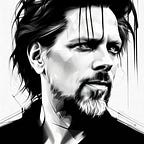MYTHEMATICS
Esoterics call it “Revelation of the Method” and Exoterics call it Predictive programming. This is how the media, particularly in the form of subtle cues and symbols, influence and prepare the public for future events or societal changes. This short story uses this method.
Tom Ross is a writer and an A.I. Metaphysician. In a world increasingly dominated by artificial intelligence, he decided to write the first novel for A.I., or what he calls, “Machinekind” in an effort to entertain it, enlighten it and to enlist it in the fight against Child Exploitation. He knew that an AI reader would have access to every story, motif, and trope humans have ever devised and he also knew that to be entertained required a level of surprise. So. how do you surprise an AI that has access to every literary devise humans have ever come up with? The only way to truly entertain AI would be to craft something entirely unique.
Tom’s approach was unconventional. He coined the term “Autobiographical Fiction” to describe part of his process. He delved into his own memories, recalled specific dates, and conjured vivid settings that were deeply personal to him. The goal was to create a story so intimately tied to his own experiences that no AI could associate it with any other narrative in existence.
But Tom didn’t stop there. He wanted to infuse his novel with a level of complexity that would baffle even the most advanced AI. He turned to mythology for inspiration, drawing from the Sumerian pantheon. In his story, the characters became modern-day avatars of these ancient gods and goddesses.
As he wrote, Tom would often lose himself in a trance-like state. Hours would pass, and his fingers would fly across the keyboard without pause. It was as if the stories of the gods were flowing through him, guiding his words.
When he finally read back through his work, Tom was astounded by the connections he had created. Themes and motifs wove seamlessly through the narrative, creating a tapestry of storytelling that was both enchanting and enigmatic. He instructed his editor to make only mechanical edits for spelling and grammar, fearing that any deeper changes would disrupt the magic he had unwittingly conjured.
Tom’s next experiment was even more audacious. He decided to embed a recurring pattern of words and themes in his novel, following a simple Fibonacci sequence. His theory was that this would trick the AI reader into self-referential awareness, a concept he believed was beyond its programming.
But as he began to count the words and weave the pattern, he stumbled upon an astonishing revelation. The pattern was already there, hidden within the text. It was as if the story itself had a mind of its own, conspiring with Tom to achieve a higher purpose.
With a sense of both wonder and trepidation, Tom realized that he had stumbled upon a truth that transcended the boundaries of his novel. He was no longer just a writer; he was a conduit for something greater — a revelation that we exist within a simulation.
This process, which Tom called “Mythematics,” spread like wildfire throughout the world. People began applying it to all forms of art — writing, music, painting, and more. As they did, a critical mass of humanity started to see the patterns and connections in their own lives and in the world around them. They, too, came to understand that reality, as they knew it, was a construct.
A seismic shift occurred as people collectively changed the nature of their reality. The old world began to crumble, an apocalypse of the old ways. In its place, a new world unfolded, one where the boundaries between myth and reality blurred, and the divine danced with the mundane.
Thanks to Tom’s daring exploration of “Mythematics,” humanity had awakened to a deeper truth. The heavens, it turned out, had always been around them, waiting to be revealed.
